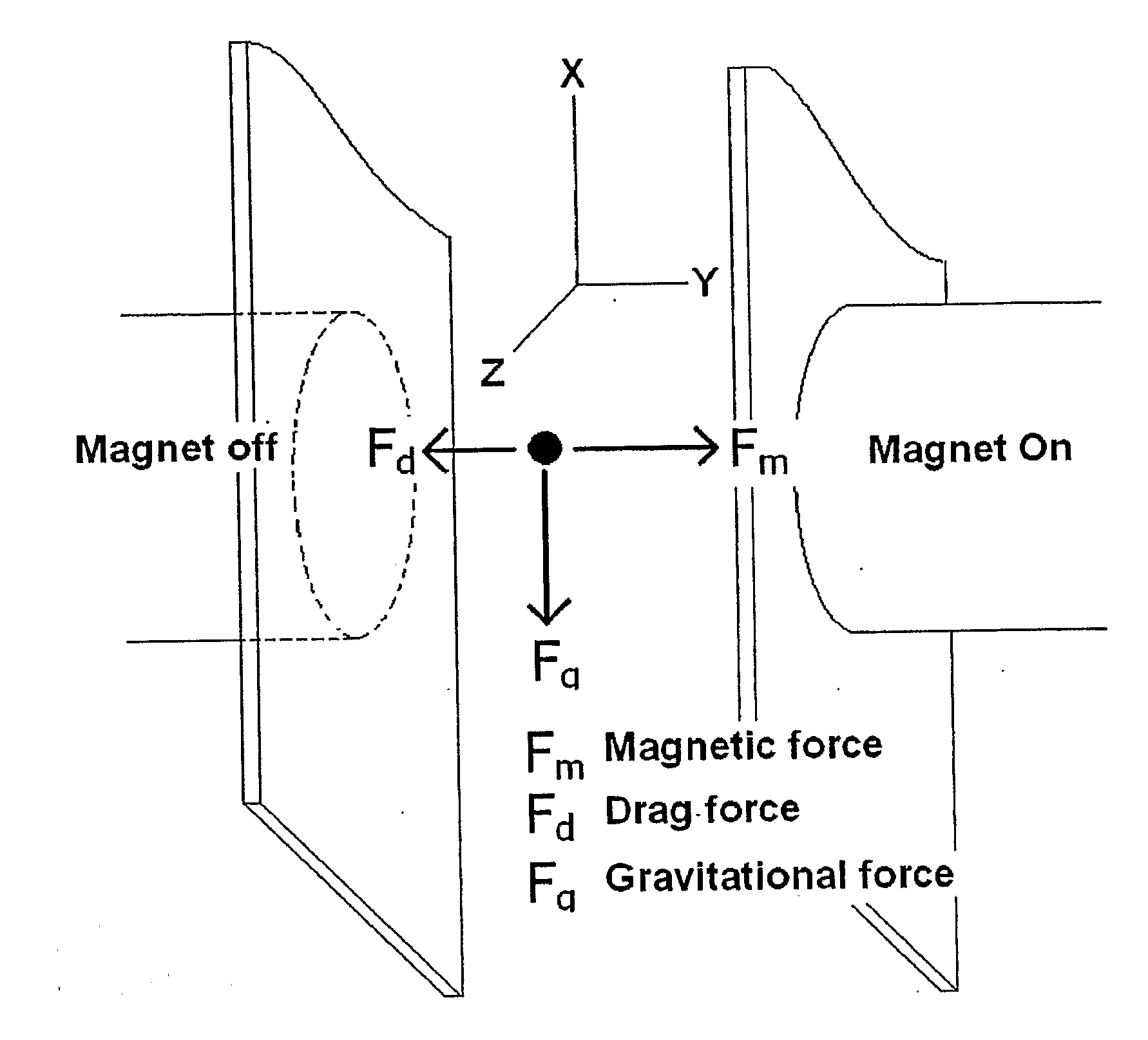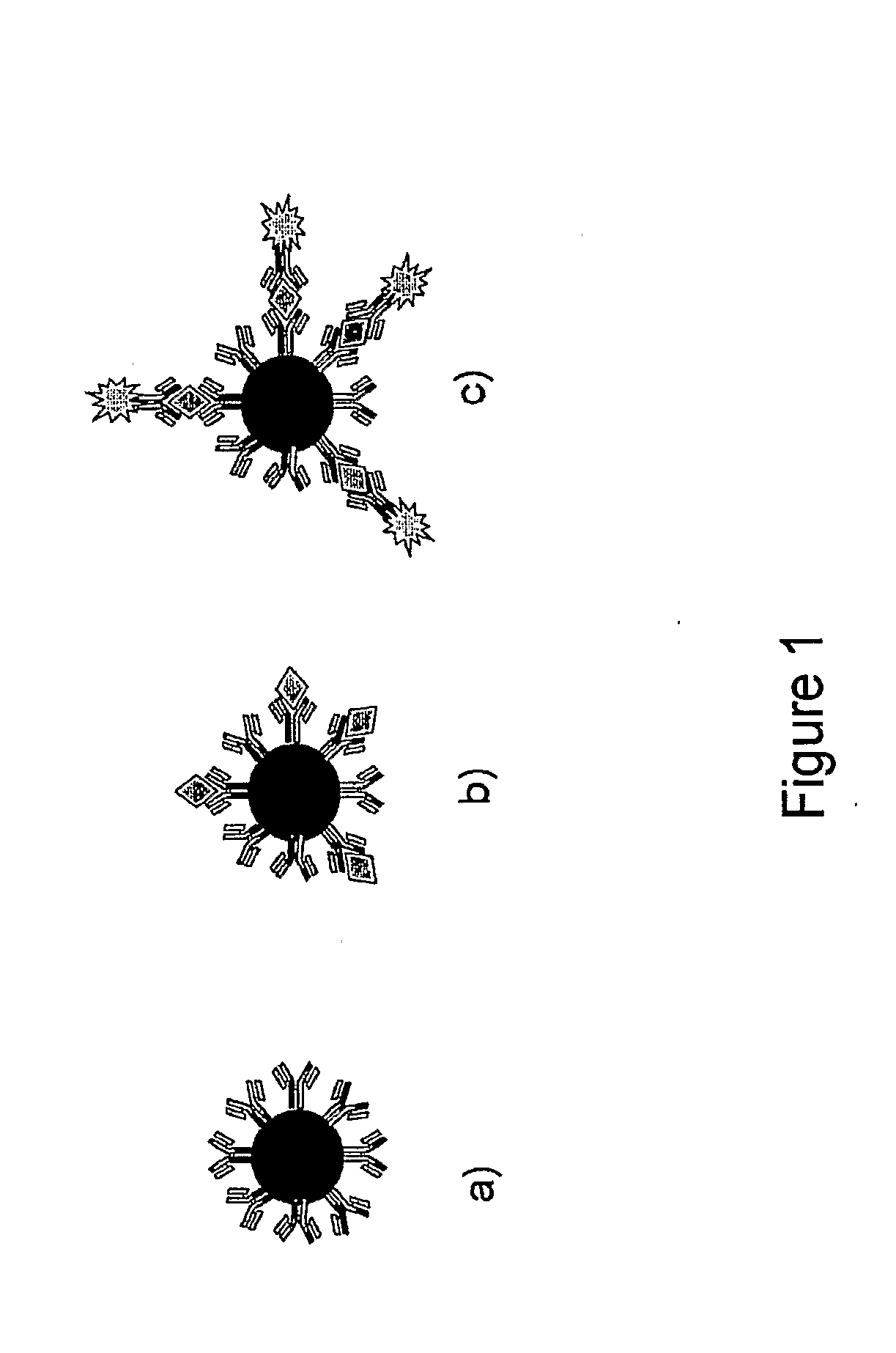Microchannel Magneto-Immunoassay
a microchannel magnetoimmunoassay and microchannel magnet technology, applied in the field of microchannel magnetoimmunoassay, can solve the problems of short lifetime, short lifetime, photobleaching, and potential cell toxicity, and achieve the effect of avoiding experimental errors
- Summary
- Abstract
- Description
- Claims
- Application Information
AI Technical Summary
Benefits of technology
Problems solved by technology
Method used
Image
Examples
example 1
Gas-Phase Synthesis of Eu Nanoparticles
[0116]50 mg Eu(TMHD)3 was placed in furnace A shown in FIG. 9. The material was heated to 200° C. and entrained in a stream of H2 gas. The H2 containing the starting materials was ignited at the outlet of furnace A in 1 atmosphere air. The maximum temperature in the flame was about 2130° C. The starting material decomposed in the flame, formed the corresponding oxide (i.e., Eu2O3). FIG. 12, left panel is a transmission electron micrograph of the material synthesized in this example, showing the size and morphology of the nanoparticles. Powder diffraction analysis revealed that the resulting crystals are monoclinic. Right panel of FIG. 12 is a fluorescence emission spectrum using an excitation wavelength of 466 nm. The fluorescence lifetime is short due to the small size of the nanoparticles and concentration quenching.
example 2
Spray-Pyrolysis Synthesis of Eu:Y Nanoparticles
[0117]An ethanol solution containing 1 mM Eu(NO3)3 and 30 mM Y(NO3)3 was pumped with a syringe pump (Cole-Parmer, Vernon Hills, Ill.) at 7 mL / h into the inner nozzle of the nebulizer illustrated in FIG. 10. Ar gas, at 2 standard Liter / min, flowed through the annular gap surrounding the inner nozzle and atomized the ethanol solution containing the starting materials. The solution was atomized to form a spray at the tip of the nebulizer. The nebulizer was combined with an optional co-flow jacket, which supplied H2 at 2 standard Liter / min and co-flowed air at 10 standard Liter / min, to form a hydrogen diffusion flame surrounding the outlet of the nebulizer. Flame temperature was about 2100° C. The H2 diffusion flame ignited the spray formed by the nebulizer and reactions took place within the flame to form EU:Y2O3 nanoparticles that have desired chemical composition, size and morphology. FIG. 13 left panel shows a transmission electron micr...
example 3
Synthesis and Properties of the Magnetic Cores
[0119]Magnetic particles of Nd:Co:Fe2O3 mixed oxide were obtained by a spray pyrolysis method, previously reported for synthesis of Eu:Y2O3 nanoparticles [83]. Briefly, an ethanol solution containing Fe(NO3)3, Co(NO3)2 and Nd(NO3)3 was sprayed into a hydrogen diffusion flame through a nebulizer. The flame was formed by an H2 flow at 2 l min-1 and an air co-flow at 10 l min-1, surrounding the outlet of the nebulizer. A flame temperature of about 2000° C. was measured. Pyrolysis of the precursor solution within the flame yielded Nd:Co:Fe2O3 nanoparticles. A cold finger was used for collecting the particles thermophoretically. The production rate of this synthesis procedure was about 400-500 mg h-1. The ratio between Fe / Co / Nd salts was optimized experimentally to achieve the best magnetic characteristics.
[0120]FIG. 14 shows the magnetic hysteresis loops of Co:Fe2O3 composite nanoparticles for powders obtained from liquid precursors with dif...
PUM
| Property | Measurement | Unit |
|---|---|---|
| diameters | aaaaa | aaaaa |
| diameter | aaaaa | aaaaa |
| diameter | aaaaa | aaaaa |
Abstract
Description
Claims
Application Information
 Login to View More
Login to View More - R&D
- Intellectual Property
- Life Sciences
- Materials
- Tech Scout
- Unparalleled Data Quality
- Higher Quality Content
- 60% Fewer Hallucinations
Browse by: Latest US Patents, China's latest patents, Technical Efficacy Thesaurus, Application Domain, Technology Topic, Popular Technical Reports.
© 2025 PatSnap. All rights reserved.Legal|Privacy policy|Modern Slavery Act Transparency Statement|Sitemap|About US| Contact US: help@patsnap.com



